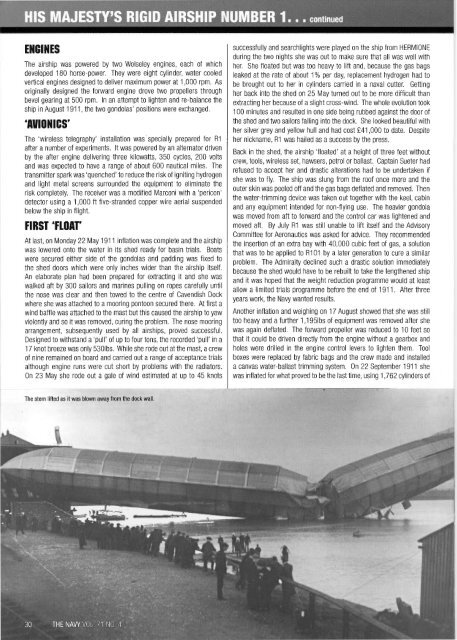VOL 71 No4 - Navy League of Australia
VOL 71 No4 - Navy League of Australia
VOL 71 No4 - Navy League of Australia
You also want an ePaper? Increase the reach of your titles
YUMPU automatically turns print PDFs into web optimized ePapers that Google loves.
ENGINES<br />
The airship was powered by two Wolseley engines, each <strong>of</strong> which<br />
developed 180 horse-power. They were eight cylinder, water cooled<br />
vertical engines designed to deliver maximum power at 1 ,000 rpm. As<br />
originally designed the forward engine drove two propellers through<br />
bevel gearing at 500 rpm. In an attempt to lighten and re-balance the<br />
ship in August 1911, the two gondolas' positions were exchanged.<br />
'AVIONICS'<br />
The 'wireless telegraphy' installation was specially prepared for R1<br />
after a number <strong>of</strong> experiments. It was powered by an alternator driven<br />
by the after engine delivering three kilowatts, 350 cycles, 200 volts<br />
and was expected to have a range <strong>of</strong> about 600 nautical miles. The<br />
transmitter spark was 'quenched' to reduce the risk <strong>of</strong> igniting hydrogen<br />
and light metal screens surrounded the equipment to eliminate the<br />
risk completely. The receiver was a modified Marconi with a 'pericon'<br />
detector using a 1 ,000 ft five-stranded copper wire aerial suspended<br />
below the ship in flight.<br />
FIRST 'FLOAT'<br />
At last, on Monday 22 May 1911 inflation was complete and the airship<br />
was lowered onto the water in its shed ready for basin trials. Boats<br />
were secured either side <strong>of</strong> the gondolas and padding was fixed to<br />
the shed doors which were only inches wider than the airship itself.<br />
An elaborate plan had been prepared for extracting it and she was<br />
walked aft by 300 sailors and marines pulling on ropes carefully until<br />
the nose was clear and then towed to the centre <strong>of</strong> Cavendish Dock<br />
where she was attached to a mooring pontoon secured there. At first a<br />
wind baffle was attached to the mast but this caused the airship to yaw<br />
violently and so it was removed, curing the problem. The nose mooring<br />
arrangement, subsequently used by all airships, proved successful.<br />
Designed to withstand a 'pull ' <strong>of</strong> up to four tons, the recorded 'pull ' in a<br />
17 knot breeze was only 5301bs. While she rode out at the mast, a crew<br />
<strong>of</strong> nine remained on board and carried out a range <strong>of</strong> acceptance trials<br />
although engine runs were cut short by problems with the radiators.<br />
On 23 May she rode out a gale <strong>of</strong> wind estimated at up to 45 knots<br />
successfully and searchlights were played on the ship from HERMIONE<br />
during the two nights she was out to make sure that all was well with<br />
her. She floated but was too heavy to lift and, because the gas bags<br />
leaked at the rate <strong>of</strong> about 1% per day, replacement hydrogen had to<br />
be brought out to her in cylinders carried in a naval cutter. Getting<br />
her back into the shed on 25 May turned out to be more difficult than<br />
extracting her because <strong>of</strong> a slight cross-wind. The whole evolution took<br />
1 00 minutes and resulted in one side being rubbed against the door <strong>of</strong><br />
the shed and two sailors falling into the dock. She looked beautiful with<br />
her silver grey and yellow hull and had cost £41 ,000 to date. Despite<br />
her nickname, R1 was hailed as a success by the press.<br />
Back in the shed, the airship 'floated ' at a height <strong>of</strong> three feet without<br />
crew, tools, wireless set, hawsers, petrol or ballast Captain Sueter had<br />
refused to accept her and drastic alterations had to be undertaken if<br />
she was to fly. The ship was slung from the ro<strong>of</strong> once more and the<br />
outer skin was peeled <strong>of</strong>f and the gas bags deflated and removed. Then<br />
the water-trimming device was taken out together with the keel , cabin<br />
and any equipment intended for non-flying use. The heavier gondola<br />
was moved from aft to forward and the control car was lightened and<br />
moved aft. By July R1 was still unable to lift itself and the Advisory<br />
Committee for Aeronautics was asked for advice. They recommended<br />
the insertion <strong>of</strong> an extra bay with 40 ,000 cubic feet <strong>of</strong> gas, a solution<br />
that was to be applied to R1 01 by a later generation to cure a similar<br />
problem. The Admiralty declined such a drastic solution immediately<br />
because the shed would have to be rebuilt to take the lengthened ship<br />
and it was hoped that the weight reduction programme would at least<br />
allow a limited trials programme before the end <strong>of</strong> 1911 . After three<br />
years work, the <strong>Navy</strong> wanted results.<br />
Another inflation and weighing on 17 August showed that she was still<br />
too heavy and a further 1, 1951bs <strong>of</strong> equipment was removed after she<br />
was again deflated. The forward propeller was reduced to 1 0 feet so<br />
that it could be driven directly from the engine without a gearbox and<br />
holes were drilled in the engine control levers to lighten them . Tool<br />
boxes were replaced by fabric bags and the crew made and installed<br />
a canvas water-ballast trimming system. On 22 September 1911 she<br />
was inflated for what proved to be the last time, using 1, 762 cylinders <strong>of</strong><br />
The stern lifted as it was blown away from the dock wall.

















